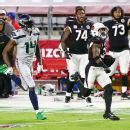More than two years after Maryland offensive lineman Jordan McNair died from heatstroke he suffered during a football workout, the university has agreed to a settlement totaling $3.5 million with his parents, Marty McNair and Tonya Wilson.
The amount, which was made public on Friday in a meeting agenda released by the Maryland Board of Public Works, must be approved at the board’s Jan. 27 meeting.
“This has been a long and painful fight, but we will attempt to find closure even though this is a wound that will never, ever fully heal,” Marty McNair and Tonya Wilson said in a joint statement issued by their attorney. “We are focused on honoring Jordan’s legacy so that his death was not in vain. This includes protecting student athletes of all levels of competition, increasing awareness, education, and prevention of all heat related illnesses, empowering student athletes, and introducing legislation nationwide so that no parent should have to wait this long for closure where their child has been treated unfairly or unjustly.”
In Maryland, tort laws in the state court limit payments to $400,000. The alternative is to file in federal court, where there is a much higher burden of proof.
Jordan McNair, a 19-year-old from Randallstown, Maryland, collapsed during an outdoor Terrapins workout on May 29, 2018 — the first conditioning practice of his sophomore season. He died two weeks later, on June 13. Questions surrounding McNair’s death began after an Aug. 10 ESPN report in which several Maryland football players and people close to the program described a coaching culture based on fear and intimidation under former coach DJ Durkin. The allegations centered around Durkin and former strength and conditioning coach Rick Court, who was one of Durkin’s first hires at Maryland in January 2016 and resigned on Aug. 14, 2018.
The reported incidents of extreme verbal abuse, using food punitively and commonly belittling and humiliating players prompted two lengthy external investigations into Maryland’s football program. The findings concluded that members of Maryland’s athletic training staff failed to quickly diagnose and properly treat McNair’s heatstroke symptoms, and ultimately resulted in the firing of Durkin, who was hired last January as an assistant coach by Lane Kiffin at Ole Miss.
“How was I so trusting of these coaches who sat at our table before signing day promising to treat him as one of their own?” Marty McNair wrote in his recently published book, “Can My Child Play?” “These same coaches who didn’t have the integrity to call us and tell us Jordan got hurt on the first day of conditioning drills. The same coach that didn’t ride in the ambulance to the hospital with our son, after promising us that he’d protect him.
“I made the wrong decision about who to trust with the thing that mattered most to me in the world.”
The May 29 workout, which was organized and led by the Maryland strength and conditioning staff, began at 4:15 p.m. ET. McNair and other linemen were near the end of their sprint set when McNair started having obvious difficulties, according to multiple sources.
Multiple witnesses at the workout told ESPN that McNair had physical difficulty before the workout ended and needed two teammates to help him complete the 10th sprint.
“There’s no way he finished on his own,” one of the players at the workout told ESPN.
“There were multiple people that said, ‘Wow, Jordan looks f—ed up, he doesn’t look all right,'” the player said. “We knew he was really exhausted, but we didn’t know he was in danger of his life. But that doesn’t mean that a medical professional shouldn’t know to put him in an ice tub.”
Multiple sources said that after the 10th sprint finished, Wes Robinson, Maryland’s former longtime head football trainer, yelled, “Drag his ass across the field!”
A second player at the workout told ESPN: “Jordan was obviously not in control of his body. He was flopping all around. There were two trainers on either side of him bearing a lot of weight. They interlocked their legs with his in order to keep him standing.”
Multiple sources estimated that trainers walked McNair around for about 80 yards after he started showing distress.
“They tried to walk him for a while after he collapsed,” the second player who spoke to ESPN said. “His head, he barely had control over it. His head was limp to the point where it was back. They were walking him across the field to get him up and moving, I guess. But then they basically took him over to position drills, which took a long time. I didn’t see them bring him in, but it was a while.”
The first player who spoke to ESPN said: “It was a good [distance] for a guy in his state to be walking, and it was away from the athletic training building, away from any resource that he probably needed at the time. Probably 100 percent the opposite way.”
A 911 call recording obtained by ESPN shows that at 5:58 p.m., an unidentified male described McNair as “hyperventilating after exercising and unable to control his breath.”
After evaluating McNair at the football facilities, EMT responders called in “male patient with a seizure,” and McNair was transported to Washington Adventist Hospital, according to the 911 call.
“I tried to keep my composure until we got to the hospital, but I couldn’t stop asking myself, “how could a 6’5, 300-pound kid who was healthy as a horse and who had never been in the hospital before have a seizure?” Marty McNair wrote in his book. “The last time I saw him, he was healthy and vibrant, with that huge gap-toothed smile. And now had been rushed off the field and into the emergency room on the first day of practice. It just didn’t make any sense.”
McNair wrote that he and Tonya were “unprepared” to see their son lying in a cooling suit to get his 106-degree body temperature down, but it wasn’t working, and Jordan was put into a medically induced coma. He later was moved to Cowley Shock Trauma Center in Baltimore.
On Aug. 14, 2018, Maryland president Wallace D. Loh and athletic director Damon Evans held a joint news conference to announce preliminary findings in their investigation into McNair’s death. They had met with McNair’s family in Baltimore and personally apologized, but Loh’s public concession of guilt that day was shocking.
“The university accepts legal and moral responsibility for the mistakes that our training staff made,” he said.
Loh had formed a committee to investigate the allegations of a toxic culture brought to light in the ESPN report, but less than a week later, the University System of Maryland Board of Regents took over the investigation and began what would morph into an entirely separate story of politics and power. The USM board added former Maryland Gov. Robert Ehrlich and former U.S. Congressman Tom McMillen, a former All-America basketball player at Maryland, to the commission tasked with investigating the program.
It wasn’t until Sept. 21 that the USM board released the findings of the first investigation, which asked Rod Walters, a sports medicine consultant, to determine whether athletic trainers followed proper protocol during their treatment of McNair at the May 29 practice. “There was a failure to identify escalating symptoms associated with exertional heat illness,” Walters said, “including assessing vital signs, identifying the condition and aggressively treating the patient’s elevated core temperature. No apparatus was used for prompt cooling of the patient.”
Walters also provided a timeline of the day that showed more than 90 minutes passed from the end of the sprints workout until McNair was transported to an area hospital.
In late October, the board of regents held two meetings to discuss the commission’s findings in the report on the Maryland football culture, which was the focus of the second investigation. Several media outlets, including ESPN, had obtained a copy of the 192-page report, which concluded there was “no toxic culture” at Maryland, and that the culture did not contribute to McNair’s death.
Investigators found disturbing things about the program under Durkin’s leadership, though, including instances of bullying and humiliation by strength coach Court. It also concluded that players did not feel comfortable going to Durkin with issues, and said the school had a dysfunctional athletic department that did not serve Durkin well in his development as a first-time head coach.
Later that month, well into the middle of the college football season and while Durkin was still in the midst of paid administrative leave, Durkin, Loh and Evans each faced the board of regents in Baltimore, one by one, with their jobs at stake. Durkin had impressed the board, and former chairman James Brady later called him “incredibly forthright” with his plan to move Maryland forward.
On Oct. 30, the USM board of regents announced its recommendation to reinstate Durkin and keep Evans in his role as Maryland’s athletic director — a decision that was met with widespread backlash. At the same news conference, Loh announced he would retire in June 2019. Sources with knowledge of the discussions told ESPN at the time that the board, which has the authority to only fire Loh, told Loh he would be fired if he didn’t reinstate Durkin, the board’s top priority. “This was not Dr. Loh’s decision,” a source said at the time.
“We believe that Coach Durkin has been unfairly blamed for the dysfunction in the athletic department,” Brady said. “While he bears some responsibility, it is not fair to place all of it at his feet.”
Durkin returned that afternoon to a team meeting in College Park, where, according to sources, a few players walked out in protest. Durkin attended the team’s practice that day. Terrapins offensive lineman Ellis McKennie, one of McNair’s closest friends, later tweeted of the board: “A group of people do not have the courage to hold anyone accountable for [McNair’s] death.”
Several Maryland politicians criticized the decision to reinstate Durkin and the USM board’s attempt to marginalize Loh. Marty McNair said at a separate Baltimore news conference, “I feel like I’ve been punched in the stomach, and somebody spit in my face.”
Political and media criticism mounted quickly. Maryland student body president Jonathan Allen told ESPN, “People are appalled by this,” and said he planned to introduce legislation that called for Loh to fire Durkin. Allen also criticized Brady, saying, “It could not have worked out better for chairman Brady.”
Political pressure continued, including a second statement from Maryland Gov. Larry Hogan, who said he was “deeply concerned at how the [USM regents] could have possibly arrived at the decisions announced [Tuesday].” Hogan called for a public meeting where the board and Loh could reconsider their decisions, ending his statement with, “The University System of Maryland has let down the University of Maryland community and the citizens of Maryland, and now is the time to fix it.”
Meanwhile, Durkin led the team’s afternoon practice, which one source described as listless.
Loh, acting independent of the USM regents, decided Durkin had to be fired. He alerted Evans, who informed Durkin in the late afternoon. Durkin was completely surprised by the decision, according to sources, and left the Gossett Football Team House without addressing players. Maryland did not fire the coach for cause.
Evans told the team that Durkin had been fired, and that Matt Canada would continue as interim coach. Marty McNair, standing outside the Gossett Football Team House, praised Loh for removing Durkin despite pressure from the board and other influential people around Maryland.
“It’s a step in the right direction,” McNair said, “to try to put some closure to this.”
The settlement was the final piece.
Source link



